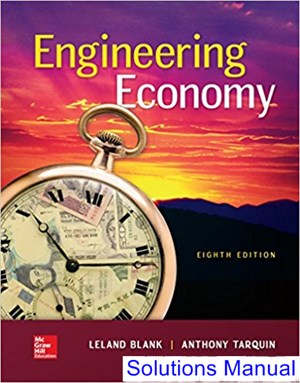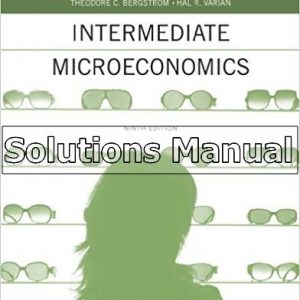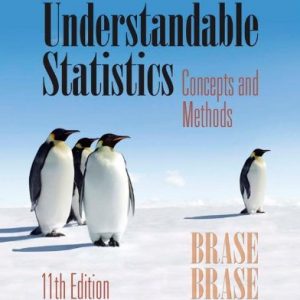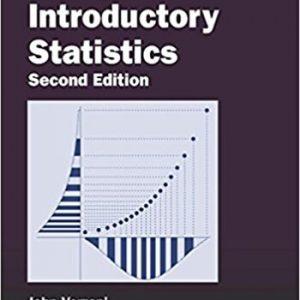This is completed downloadable of Engineering Economy 8th Edition Blank Solutions Manual

Product Details:
- ISBN-10 : 0073523437
- ISBN-13 : 978-0073523439
- Author;
Engineering Economy presents a crisp, bold new design using color, highlighting and icons to focus on important concepts, terms, equations and decision guidelines. There are new features, new topics (such as ethics and staged decision making), and new online tools; yet no compromise on coverage, examples, or the well-accepted writing style of this popular text. Solved examples, problems and case studies target many of the current engineering challenges in areas such as energy, ethics, the environment, and the world’s changing economics.
McGraw-Hill’s Connect, is also available as an optional, add on item. Connect is the only integrated learning system that empowers students by continuously adapting to deliver precisely what they need, when they need it, how they need it, so that class time is more effective. Connect allows the professor to assign homework, quizzes, and tests easily and automatically grades and records the scores of the student’s work. Problems are randomized to prevent sharing of answers an may also have a “multi-step solution” which helps move the students’ learning along if they experience difficulty.
Table of Content:
- Chapter 1 Foundations of Engineering Economy
- 1.1 Why Engineering Economy and the Time Value of Money are Important
- 1.2 Performing an Engineering Economy Study
- 1.3 Professional Ethics and Economic Decisions
- 1.4 Interest Rate and Rate of Return
- 1.5 Terminology and Symbols
- 1.6 Cash Flows: Estimation and Diagramming
- 1.7 Economic Equivalence
- 1.8 Simple and Compound Interest
- 1.9 Minimum Attractive Rate of Return
- 1.10 Introduction to Spreadsheet Use
- Chapter Summary
- Problems
- Exercises for Spreadsheets
- Additional Problems and FE Exam Review Questions
- Case Study—Cost of Electricity with Renewable Sources Added
- Chapter 2 Factors: How Time and Interest Affect Money
- Progressive Example—The Steel Plant Case
- 2.1 Single-Amount Factors (F/P and P/F)
- 2.2 Uniform Series Present Worth Factor and Capital Recovery Factor (P/A and A/P)
- 2.3 Sinking Fund Factor and Uniform Series Compound Amount Factor (A/F and F/A)
- 2.4 Factor Values for Untabulated i or n Values
- 2.5 Arithmetic Gradient Factors (P/G and A/G)
- 2.6 Geometric Gradient Series Factors
- 2.7 Determining i or n for Known Cash Flow Values
- Chapter Summary
- Problems
- Exercises for Spreadsheets
- Additional Problems and FE Exam Review Questions
- Case Study—The Amazing Impact of Compound Interest
- Chapter 3 Combining Factors and Spreadsheet Functions
- 3.1 Calculations for Uniform Series That Are Shifted
- 3.2 Calculations Involving Uniform Series and Randomly Placed Single Amounts
- 3.3 Calculations for Shifted Gradients
- Chapter Summary
- Problems
- Exercises for Spreadsheets
- Additional Problems and FE Exam Review Questions
- Case Study—Preserving Land for Public Use
- Chapter 4 Nominal and Effective Interest Rates
- Progressive Example—The Credit Card Offer Case
- 4.1 Nominal and Effective Interest Rate Statements
- 4.2 Effective Annual Interest Rates
- 4.3 Effective Interest Rates for Any Time Period
- 4.4 Equivalence Relations: Payment Period and Compounding Period
- 4.5 Equivalence Relations: Single Amounts with PP ≥ CP
- 4.6 Equivalence Relations: Series with PP ≥ CP
- 4.7 Equivalence Relations: Single Amounts and Series with PP < CP
- 4.8 Effective Interest Rate for Continuous Compounding
- 4.9 Interest Rates That Vary Over Time
- Chapter Summary
- Problems
- Exercises for Spreadsheets
- Additional Problems and FE Exam Review Questions
- Case Study—Is Owning a Home a Net Gain or Net Loss Over Time
- Learning Stage 2 Basic Analysis Tools
- Chapter 5 Present Worth Analysis
- Progressive Example—Water for Semiconductor Manufacturing Case
- 5.1 Formulating Alternatives
- 5.2 Present Worth Analysis of Equal-Life Alternatives
- 5.3 Present Worth Analysis of Different-Life Alternatives
- 5.4 Future Worth Analysis
- 5.5 Capitalized Cost Analysis
- Chapter Summary
- Problems
- Exercises for Spreadsheets
- Additional Problems and FE Exam Review Questions
- Case Study—Comparing Social Security Benefits
- Chapter 6 Annual Worth Analysis
- 6.1 Advantages and Uses of Annual Worth Analysis
- 6.2 Calculation of Capital Recovery and AW Values
- 6.3 Evaluating Alternatives by Annual Worth Analysis
- 6.4 AW of a Permanent Investment
- 6.5 Life-Cycle Cost Analysis
- Chapter Summary
- Problems
- Exercises for Spreadsheets
- Additional Problems and FE Exam Review Questions
- Case Study—Annual Worth Analysis—Then and Now
- Chapter 7 Rate of Return Analysis: One Project
- 7.1 Interpretation of a Rate of Return Value
- 7.2 Rate of Return Calculation Using a PW or AW Relation
- 7.3 Special Considerations When Using the ROR Method
- 7.4 Multiple Rate of Return Values
- 7.5 Techniques to Remove Multiple Rates of Return
- 7.6 Rate of Return of a Bond Investment
- Chapter Summary
- Problems
- Exercises for Spreadsheets
- Additional Problems and FE Exam Review Questions
- Case Study—Developing and Selling an Innovative Idea
- Chapter 8 Rate of Return Analysis: Multiple Alternatives
- 8.1 Why Incremental Analysis Is Necessary
- 8.2 Calculation of Incremental Cash Flows for ROR Analysis
- 8.3 Interpretation of Rate of Return on the Extra Investment
- 8.4 Rate of Return Evaluation Using PW: Incremental and Breakeven (Two Alternatives)
- 8.5 Rate of Return Evaluation Using AW
- 8.6 Incremental ROR Analysis of Multiple (More than Two) Alternatives
- 8.7 All-in-One Spreadsheet Analysis
- Chapter Summary
- Problems
- Exercises for Spreadsheets
- Additional Problems and FE Exam Review Questions
- Case Study—Peforming ROR Analysis for 3D Printer and IIoT Technology
- Case Study—How a New Engineering Graduate Can Help His Father
- Chapter 9 Benefit/Cost Analysis and Public Sector Economics
- Progressive Example—Water Treatment Facility #3 Case
- 9.1 Public Sector Projects
- 9.2 Benefit/Cost Analysis of a Single Project
- 9.3 Incremental B/C Analysis (Two Alternatives)
- 9.4 Incremental B/C Analysis of Multiple (More than Two) Alternatives
- 9.5 Service Sector Projects and Cost-Effectiveness Analysis
- 9.6 Ethical Considerations in the Public Sector
- Chapter Summary
- Problems
- Exercises for Spreadsheets
- Additional Problems and FE Exam Review Questions
- Case Study—Highway Lighting Options to Reduce Traffic Accidents
- Learning Stage 2 Epilogue: Selecting The Basic Analysis Tool
- Learning Stage 3 Making Better Decisions
- Chapter 10 Project Financing and Noneconomic Attributes
- 10.1 MARR Relation to the Cost of Capital
- 10.2 Debt-Equity Mix and Weighted Average Cost of Capital
- 10.3 Determination of the Cost of Debt Capital
- 10.4 Determination of the Cost of Equity Capital and the MARR
- 10.5 Effect of Debt-Equity Mix on Investment Risk
- 10.6 Multiple Attribute Analysis: An Introduction
- 10.7 Evaluation Measure for Multiple Attributes
- Chapter Summary
- Problems
- Exercises for Spreadsheets
- Additional Problems and FE Exam Review Questions
- Case Study—Expanding a Business—Debt vs. Equity Financing
- Chapter 11 Replacement and Retention Decisions
- Progressive Example—Keep or Replace the Kiln Case
- 11.1 Basics of a Replacement Study
- 11.2 Economic Service Life
- 11.3 Performing a Replacement Study
- 11.4 Additional Considerations in a Replacement Study
- 11.5 Replacement Study over a Specified Study Period
- 11.6 Replacement Value
- Chapter Summary
- Problems
- Exercises for Spreadsheets
- Additional Problems and FE Exam Review Questions
- Case Study—A Pumper System with an ESL Problem
- Chapter 12 Independent Projects with Budget Limitation
- 12.1 An Overview of Capital Rationing among Projects
- 12.2 Capital Rationing Using PW Analysis of Equal-Life Projects
- 12.3 Capital Rationing Using PW Analysis of Unequal-Life Projects
- 12.4 Capital Budgeting Problem Formulation Using Linear Programming
- 12.5 Additional Project Ranking Measures
- Chapter Summary
- Problems
- Additional Problems and FE Exam Review Questions
- Chapter 13 Breakeven and Payback Analysis
- 13.1 Breakeven Analysis for a Single Project
- 13.2 Breakeven Analysis Between Two Alternatives
- 13.3 Payback Analysis
- 13.4 More Breakeven and Payback Analysis on Spreadsheets
- Chapter Summary
- Problems
- Exercises for Spreadsheets
- Additional Problems and FE Exam Review Questions
- Case Study—Water Treatment Plant Process Costs
- Learning Stage 4 Rounding Out the Study
- Chapter 14 Effects of Inflation
- 14.1 Understanding the Impact of Inflation
- 14.2 Present Worth Calculations Adjusted for Inflation
- 14.3 Future Worth Calculations Adjusted for Inflation
- 14.4 Capital Recovery Calculations Adjusted for Inflation
- Chapter Summary
- Problems
- Additional Problems and FE Exam Review Questions
- Case Study—Inflation Considerations for Stock and Bond Investments
- Chapter 15 Cost Estimation and Indirect Cost Allocation
- 15.1 Understanding How Cost Estimation Is Accomplished
- 15.2 Unit Method
- 15.3 Cost Indexes
- 15.4 Cost-Estimating Relationships: Cost-Capacity Equations
- 15.5 Cost-Estimating Relationships: Factor Method
- 15.6 Indirect Cost Rates and Allocation: The Traditional Method
- 15.7 Activity-Based Costing (ABC) for Indirect Costs
- 15.8 Making Estimates and Maintaining Ethical Practices
- Chapter Summary
- Problems
- Additional Problems and FE Exam Review Questions
- Case Study—Indirect Cost Analysis of Medical Equipment Manufacturing Costs
- Case Study—Deceptive Acts Can Get You in Trouble
- Chapter 16 Depreciation Methods
- 16.1 Depreciation Terminology
- 16.2 Straight Line (SL) Depreciation
- 16.3 Declining Balance (DB) and Double Declining Balance (DDB) Depreciation
- 16.4 Modified Accelerated Cost Recovery System (MACRS)
- 16.5 Determining the MACRS Recovery Period
- 16.6 Depletion Methods
- Chapter Summary
- Appendix
- 16A.1 Sum-of-Years-Digits (SYD) and Unit-of-Production (UOP) Depreciation
- 16A.2 Switching between Depreciation Methods
- 16A.3 Determination of MACRS Rates
- Problems
- Additional Problems and FE Exam Review Questions
- Appendix Problems
- Chapter 17 After-Tax Economic Analysis
- 17.1 Income Tax Terminology and Basic Relations
- 17.2 Calculation of Cash Flow after Taxes
- 17.3 Effect on Taxes of Different Depreciation Methods and Recovery Periods
- 17.4 Depreciation Recapture and Capital Gains (Losses)
- 17.5 After-Tax Economic Evaluation
- 17.6 After-Tax Replacement Study
- 17.7 After-Tax Value-Added Analysis
- 17.8 After-Tax Analysis for International Projects
- 17.9 Value-Added Tax
- Chapter Summary
- Problems
- Additional Problems and FE Exam Review Questions
- Case Study—After-Tax Analysis for Business Expansion
- Chapter 18 Sensitivity Analysis and Staged Decisions
- 18.1 Determining Sensitivity to Parameter Variation
- 18.2 Sensitivity Analysis Using Three Estimates
- 18.3 Estimate Variability and the Expected Value
- 18.4 Expected Value Computations for Alternatives
- 18.5 Staged Evaluation of Alternatives Using a Decision Tree
- 18.6 Real Options in Engineering Economics
- Chapter Summary
- Problems
- Additional Problems and FE Exam Review Questions
- Case Study—Sensitivity to the Economic Environment
- Case Study—Sensitivity Analysis of Public Sector Projects—Water Supply Plans
- Chapter 19 More on Variation and Decision Making under Risk
- 19.1 Interpretation of Certainty, Risk, and Uncertainty
- 19.2 Elements Important to Decision Making under Risk
- 19.3 Random Samples
- 19.4 Sample Estimates: Mean and Standard Deviation
- 19.5 Monte Carlo Sampling and Simulation Analysis
- Chapter Summary
- Problems
- Additional Problems and FE Exam Review Questions
- Case Study—Using Simulation and Three-Estimate Sensitivity Analysis
- Appendix A Using Spreadsheets and Microsoft Excel®
- A.1 Introduction to Using Excel
- A.2 Organization (Layout) of the Spreadsheet
- A.3 Spreadsheet Functions Important to Engineering Economy (Alphabetical Order)
- A.4 Goal Seek—A Tool for Breakeven and Sensitivity Analysis
- A.5 Solver—An Optimizing Tool for Capital Budgeting, Breakeven, and Sensitivity Analysis
- A.6 Error Messages
- Appendix B Basics of Accounting Reports and Business Ratios
- B.1 The Balance Sheet
- B.2 Income Statement and Cost of Goods Sold Statement
- B.3 Business Ratios
- Appendix C Code of Ethics for Engineers
- Appendix D Alternate Methods for Equivalence Calculations
- D.1 Using Programmable Calculators
- D.2 Using the Summation of a Geometric Series
- Appendix E Glossary of Concepts and Terms
- E.1 Important Concepts and Guidelines
- E.2 Symbols and Terms
- Reference Materials
- Factor Tables
- Index





